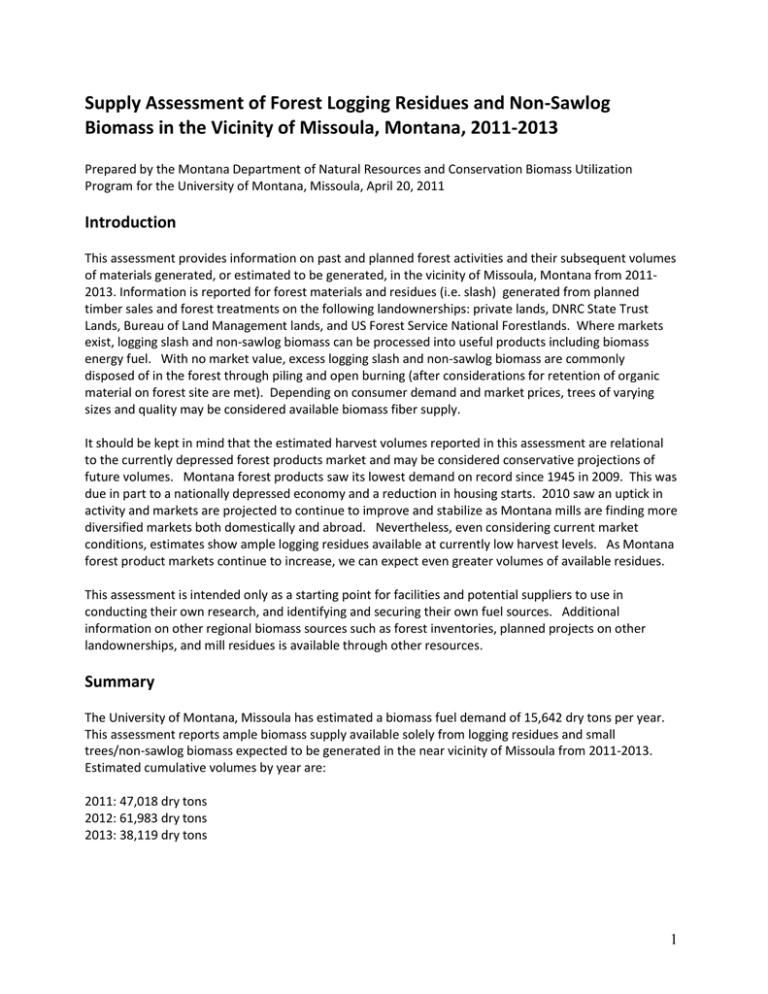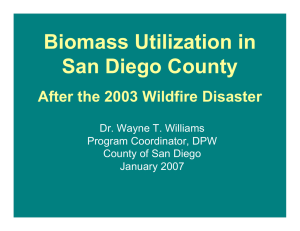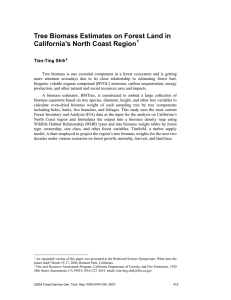Supply Assessment of Forest Logging Residues and Non-Sawlog
advertisement

Supply Assessment of Forest Logging Residues and Non-Sawlog Biomass in the Vicinity of Missoula, Montana, 2011-2013 Prepared by the Montana Department of Natural Resources and Conservation Biomass Utilization Program for the University of Montana, Missoula, April 20, 2011 Introduction This assessment provides information on past and planned forest activities and their subsequent volumes of materials generated, or estimated to be generated, in the vicinity of Missoula, Montana from 20112013. Information is reported for forest materials and residues (i.e. slash) generated from planned timber sales and forest treatments on the following landownerships: private lands, DNRC State Trust Lands, Bureau of Land Management lands, and US Forest Service National Forestlands. Where markets exist, logging slash and non-sawlog biomass can be processed into useful products including biomass energy fuel. With no market value, excess logging slash and non-sawlog biomass are commonly disposed of in the forest through piling and open burning (after considerations for retention of organic material on forest site are met). Depending on consumer demand and market prices, trees of varying sizes and quality may be considered available biomass fiber supply. It should be kept in mind that the estimated harvest volumes reported in this assessment are relational to the currently depressed forest products market and may be considered conservative projections of future volumes. Montana forest products saw its lowest demand on record since 1945 in 2009. This was due in part to a nationally depressed economy and a reduction in housing starts. 2010 saw an uptick in activity and markets are projected to continue to improve and stabilize as Montana mills are finding more diversified markets both domestically and abroad. Nevertheless, even considering current market conditions, estimates show ample logging residues available at currently low harvest levels. As Montana forest product markets continue to increase, we can expect even greater volumes of available residues. This assessment is intended only as a starting point for facilities and potential suppliers to use in conducting their own research, and identifying and securing their own fuel sources. Additional information on other regional biomass sources such as forest inventories, planned projects on other landownerships, and mill residues is available through other resources. Summary The University of Montana, Missoula has estimated a biomass fuel demand of 15,642 dry tons per year. This assessment reports ample biomass supply available solely from logging residues and small trees/non-sawlog biomass expected to be generated in the near vicinity of Missoula from 2011-2013. Estimated cumulative volumes by year are: 2011: 47,018 dry tons 2012: 61,983 dry tons 2013: 38,119 dry tons 1 70000 Figure 1 Estimated cumulative volumes of biomass from logging slash residue and small trees (<7" diameter) generated by planned forest treatments and timber harvests in vicinity of Missoula, MT, 2011-2013 Lolo N.F. 60000 Bitterroot N.F. Biomass (dry tons) 50000 BLM Lands 40000 DNRC State Lands 30000 Private Lands 20000 UM Biomass Fuel Demand 10000 0 2011 2012 2013 Year Refer to section titled Supply Availability by Landownership for reference information on estimated volumes reported in Figure 1. Methodology This assessment provides information on past and planned forest activities and their subsequent volumes of materials generated, or estimated to be generated, in the vicinity of Missoula, Montana from 20112013. Because land management agencies generally create plans for timber sales 2-5 years out, we currently only have data up to year 2013. Information is reported for forest products and residuals generated from planned timber sales and forest treatments on the following landownerships: private lands, DNRC State Trust Lands, Bureau of Land Management lands, and US Forest Service National Forestlands. Volumes reported are based on information that was available at the time of the assessment and is subject to change. 1. Assessment Area A. Private lands are reported within the county boundaries of Missoula, Granite, Mineral, and Ravalli Counties. 2 B. State lands are reported for the area within the administrative boundaries of the DNRC Unit Offices in Missoula, Hamilton and Greenough. C. Bureau of Land Management lands are reported for the area within the administrative boundaries of the Missoula Field Office. D. National Forest lands are reported for the area contained within the boundaries of the Lolo and Bitterroot National Forests. 2. Volumes Reported and Metrics Used Two main biomass sources are reported in this assessment—logging residue/slash and non-sawlog biomass. logging residues/slash—biomass residues generated as by-product of sawlog harvest (tree tops, cull logs, limbs, and branches). The logging residue/slash volumes are conservative estimates for western Montana forests, calculated at 0.45 dry tons of residue generated per 1,000 board feet (MBF) of sawlogs harvested. non-sawlog biomass—materials generated from harvest of trees less than 7 inches diameter at breast height (DBH) A few very simplified “rules of thumb” for timber and biomass metrics for Western Montana: MBF = 1000 board feet 1 MBF sawlogs harvested generates 0.45 dry tons of slash/MBF. 1 MBF= 6.5 green tons 1 MBF = 8 trees 1 tree= 125 board feet 1 acre timber harvest generates, on average, 5-7 MBF/acre Supply Availability by Landownership A. Private Forestlands It is not possible to predict the location and quantity of harvests on private lands, but we can make informed estimates of future harvests based on historic activity. The Cut-by-County Reports published annually by DNRC provide information about the harvested volumes of forested material delivered to purchasing mills. Data in Table 1 reports the volume of sawlogs harvested from both industrial and nonindustrial private lands and the estimated logging residues (slash) generated from those harvests. Volumes for materials harvested for other markets such as pulpwood, house logs, posts, poles, rails, and firewood are not included. Additionally, volumes from materials generated from forest thinning projects that may have occurred, but did not involve commercial products, are not included here. 3 Table 1. Private Lands Missoula, Mineral, Granite and Ravalli Counties Cumulative volumes generated from timber harvests, 2001-2010 Estimated Logging Sawlog Harvest Residues Year (MBF) (dry tons) 2010 27,260 12,267 2009 17,589 7,915 2008 58,555 26,350 2007 77,528 34,888 2006 105,444 47,450 2005 122,792 55,256 2004 142,822 64,270 2003 138,007 62,103 2002 146,577 65,960 2001 156,693 70,512 Source: Montana DNRC Cut-by-County Summary: Private Lands Harvest from 1992 thru 2009; 2010 Cutby-County Report. B. DNRC State Trust Lands Table 2. DNRC lands administered by Missoula, Hamilton and Clearwater Unit Offices Estimated volumes generated from planned harvests, 2011-2013 Year 2011 2012 2013 Sawlog Harvest (MBF) 20,061 17,300 17,050 Logging Residues (dry tons) 9,027 7,785 7,672 Source: Montana DNRC Southwest Land Office Timber Sale Project List and Schedule, Fiscal Year 2011. 4 C. Bureau of Land Management, Missoula Field Office Note: Data for 2013 was not available at time of assessment. Table 3. BLM Missoula Field Office Estimated volumes generated from planned harvests, 2011-2012 Year 2011 2011 2011 2012 Project Locale Helmville Hall Seeley Lake Drummond Sawlog Harvest (MBF) 7,902 561 331 6,206 Logging Residues (dry tons) 4,124 293 172 3,239 Non-Sawlog Biomass Harvest (dry tons) 7,380 0 0 5,520 Total Biomass from Logging Residues and Non-Sawlog Harvest (dry tons) 11,504 293 172 8,759 Source: John Wienert, Forester, Missoula Field Office, Bureau of Land Management. 11 April 2011. D. National Forest Lands Volumes reported for material in the following size ranges: Non-sawlog biomass = material ≤ 7” DBH Small log = material >7”-12” DBH Large log = material >12” DBH Lolo National Forest The information in Table 4 below was retrieved from the Western Montana Coordinated Resource Offering Protocol (CROP) website—an interactive website that provides broad level information on timber sales and forest material offerings planned in regions of Western Montana in the near term. Table 4. Lolo National Forest Estimated volumes generated from planned harvests, 2011-2013 Year 2011 2012 2013 Small Log Harvests (MBF) 7,881 17,733 10,696 Logging Residue Generated from Small Logs (dry tons) 3,546 7,980 4,813 Large Log Harvests (MBF) 4,764 10,720 6,466 Logging Residue Generated from Large Logs (dry tons) 2,144 4,824 2,910 NonSawlog Biomass Harvest (dry tons) 4,055 9,125 5,504 Total Biomass from Logging Residues and Non-Sawlog Harvest (dry tons) 9,746 21,929 13,227 Source: Western Montana Coordinated Resource Offering Protocol (CROP). http://www.cropusa.com/w_montana/Lolo_NF.php. 5 Bitterroot National Forest Year 2011 2012 2013 2014 2015 Sawlog Harvest (MBF) 3,400 6,500 5,500 5,500 5,500 Table 5. Bitterroot National Forest Estimated volumes generated from planned harvests, 2011-2015 Total Biomass from Logging Logging Residue Non-Sawlog Biomass Residues and Non-Sawlog (dry tons) (dry tons) Harvest (dry tons) 1,530 2,478 4,008 2,925 2,478 5,403 2,475 2,478 4,953 2,475 2,478 4,953 2,475 2,478 4,953 Sources: USFS Region 1. Bitterroot National Forest, 5-Year Timber Plan, 2011-2015; Western Montana Coordinated Resource Offering Protocol (CROP). http://www.cropusa.com/w_montana/Bitterroot_NF.php. Conclusion The University of Montana, Missoula has estimated a biomass fuel demand of 15,642 dry tons per year. This assessment reports ample biomass supply available solely from logging residues and small trees/non-sawlog biomass expected to be generated in the near vicinity of Missoula from 2011-2013. 2011 estimates are 47,018 dry tons, 2012 estimates are 61,983 dry tons, and 2013 estimates are 38,119 dry tons. The estimated harvest volumes reported in this assessment—given their relation to the currently depressed forest products market—may be considered conservative projections of future harvest. Nevertheless, even considering the current market conditions, these estimates show sufficient logging residues available at currently low harvest levels. As Montana forest product markets continue to improve and stabilize, we can expect even greater volumes of available residues. This assessment is intended only as a starting point for facilities and potential suppliers to use in conducting their own research, and identifying and securing their own fuel sources. Additional information on other regional biomass sources such as forest inventories, planned projects on other landownerships, and mill residues is available through other resources. 6




